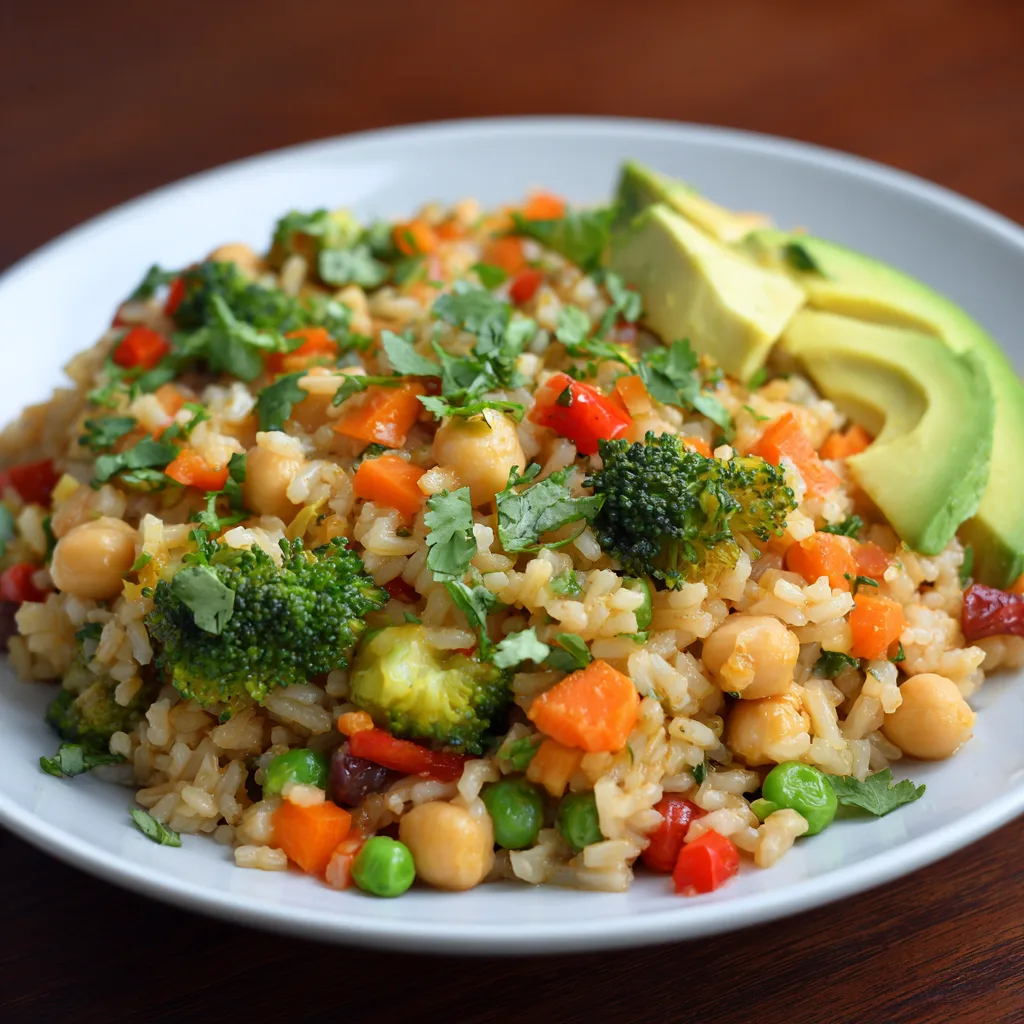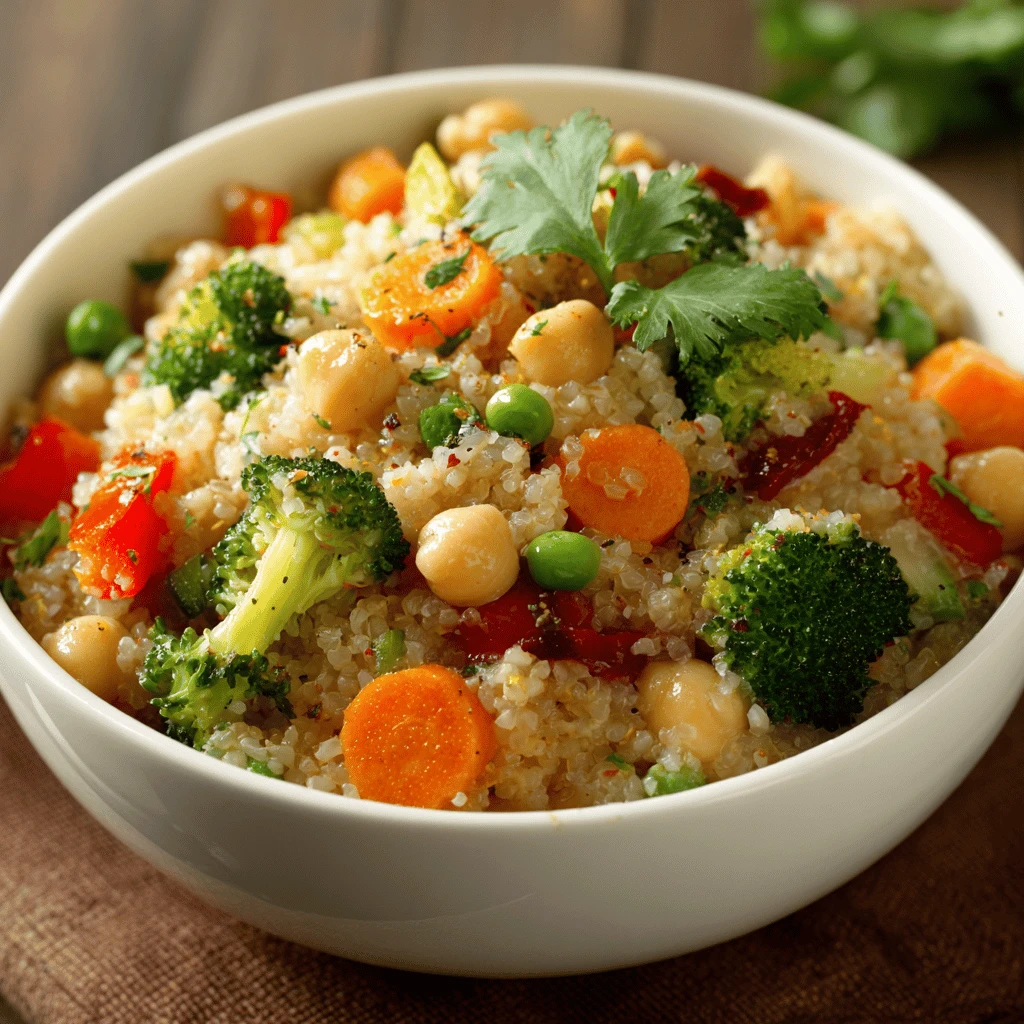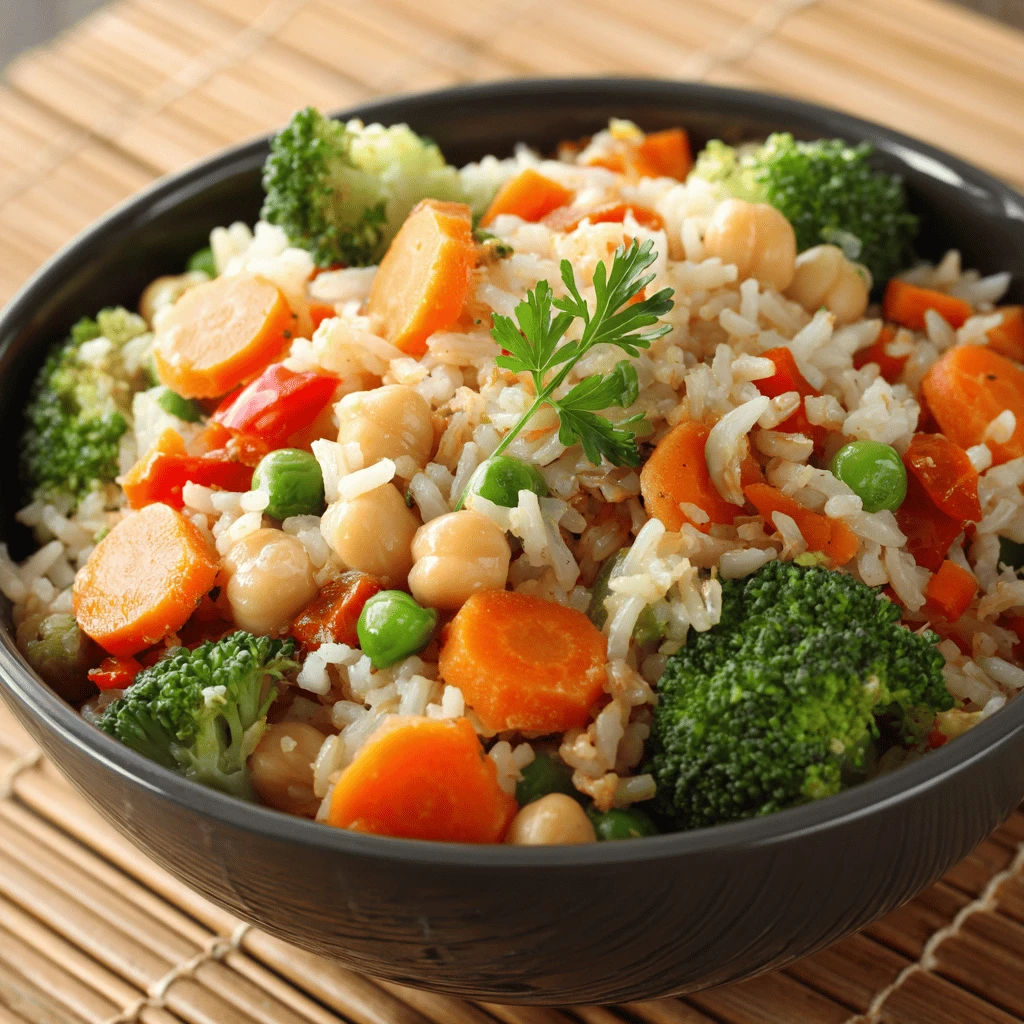High Protein Crockpot Vegetables Rice
Ingredients
- 1 cup brown rice, uncooked
- 2 cups vegetable broth (low sodium)
- 1 cup chopped broccoli florets
- 1 cup chopped carrots
- 1 cup chopped bell peppers (any color)
- 1/2 cup frozen peas
- 1 (15-ounce) can chickpeas, drained and rinsed
- 1 (15-ounce) can black beans, drained and rinsed
- 1/2 cup crumbled firm tofu (high protein option)
- 2 tablespoons olive oil
- 1 teaspoon garlic powder
- 1/2 teaspoon onion powder
- 1/4 teaspoon red pepper flakes (optional)
- Salt and pepper to taste
- Optional garnishes: chopped cilantro, avocado slices, a squeeze of lime juice
Step-by-Step
1. Rinse the brown rice thoroughly under cold water. This helps remove excess starch.
2. Add the rinsed brown rice and vegetable broth to the crockpot.
3. Stir in the chopped broccoli, carrots, and bell peppers.
4. Add the frozen peas, chickpeas, and black beans to the crockpot.
5. If using, crumble the firm tofu and add it to the mixture.
6. Drizzle the olive oil over the ingredients in the crockpot.
7. Sprinkle with garlic powder, onion powder, red pepper flakes (if using), salt, and pepper.
8. Stir all the ingredients together well, ensuring everything is evenly distributed.
9. Cover the crockpot and cook on low for 3-4 hours, or until the rice is tender and the vegetables are cooked through. Cooking times can vary depending on your crockpot.
10. Once cooked, fluff the rice with a fork and taste to adjust seasoning as needed.
11. Serve hot, garnished with chopped cilantro, avocado slices, or a squeeze of lime juice, if desired.
12. Enjoy your healthy and delicious high-protein crockpot vegetables and rice!
Benefits of High Protein Crockpot Meals
Crockpot cooking offers unparalleled convenience. It’s ideal for busy individuals. A high protein crockpot meal provides numerous health advantages.
H3: Convenience and Time-Saving
Crockpot cooking is perfect for meal prepping. Just load the ingredients and let it cook. This frees up your time for other activities. You can come home to a ready-made, nutritious meal.
H3: Nutritional Advantages of High Protein
Protein is essential for muscle building and repair. It also keeps you feeling full and satisfied. This can help with weight management. High protein meals can help regulate blood sugar levels.
H3: Cost-Effectiveness
Crockpot meals often utilize inexpensive ingredients. Beans, rice, and vegetables are budget-friendly. Buying in bulk can further reduce costs. You can prepare large batches for multiple meals.
Selecting the Right Ingredients
The quality of ingredients significantly impacts the final dish. Choose fresh vegetables and high-quality protein sources. Consider organic options when possible.
H3: Choosing Vegetables for Flavor and Nutrition
Select a variety of colorful vegetables. Different colors offer different nutrients. Broccoli, carrots, and bell peppers provide essential vitamins. Frozen vegetables are a convenient and nutritious alternative.
H3: Protein Sources: Plant-Based and Beyond
Plant-based proteins like beans and tofu are excellent choices. They offer fiber and essential nutrients. Lean meats, such as chicken or turkey, can also be used. Consider the protein content and overall nutritional value.
H3: The Importance of Quality Rice
Brown rice is a healthier alternative to white rice. It is higher in fiber and nutrients. Ensure the rice is properly rinsed before cooking. This removes excess starch.
Customizing Your Crockpot Vegetables Rice
This recipe is incredibly versatile. You can easily adapt it to your dietary preferences. Experiment with different vegetables, proteins, and seasonings.
H3: Vegetarian and Vegan Adaptations
This recipe is naturally vegetarian. To make it vegan, ensure your vegetable broth is plant-based. Tofu, tempeh, or lentils are great protein additions. Nutritional yeast can add a cheesy flavor.
H3: Adding Different Flavors and Spices
Experiment with various spices and herbs. Cumin, chili powder, or smoked paprika can add depth. Fresh herbs like cilantro or parsley enhance the flavor. Adjust the seasonings to your taste.
H3: Incorporating Different Vegetables
Consider adding other vegetables such as zucchini, mushrooms, or spinach. Root vegetables like sweet potatoes or parsnips can be used. Adapt the vegetables based on seasonal availability.
Tips for Perfect Crockpot Cooking
Mastering crockpot cooking involves a few key techniques. Proper liquid ratios and cooking times are crucial. Prevent mushy vegetables with these tips.
H3: Liquid Ratios and Cooking Times
Use the correct amount of liquid to avoid dry or mushy results. The ratio of liquid to rice is important. Monitor the cooking time to prevent overcooking. Every crockpot cooks differently, so adjust accordingly.
H3: Preventing Mushy Vegetables
Add vegetables that cook quickly later in the process. This helps retain their texture. Avoid overcooking by checking the vegetables periodically. Frozen vegetables tend to cook faster.
H3: Crockpot Safety and Maintenance
Always ensure the crockpot is properly sealed. Clean the crockpot thoroughly after each use. Follow the manufacturer’s instructions for safe operation. Avoid using abrasive cleaners that can damage the surface.
Serving Suggestions and Meal Planning
This high protein crockpot meal is versatile. It can be served as a main course or a side dish. Explore different serving options.
H3: Serving as a Main Course
Serve the crockpot vegetables and rice as a complete meal. Add a side salad for extra nutrients. Garnish with avocado slices for healthy fats. A squeeze of lime juice brightens the flavors.
H3: Using as a Side Dish
Serve alongside grilled chicken, fish, or tofu. This provides a balanced meal. The vegetables and rice complement many dishes. Adjust the portion sizes accordingly.
H3: Meal Planning and Storage
Prepare a large batch for meal prepping. Store leftovers in an airtight container in the refrigerator. This meal is great for lunch or dinner. It can be easily reheated.
FAQ
What if my rice is still hard after the recommended cooking time?
Add a little more vegetable broth (about 1/4 cup) and continue cooking for another 30-60 minutes, checking periodically.
Can I use white rice instead of brown rice?
Yes, but you’ll need to adjust the cooking time and liquid. White rice cooks much faster. Reduce the cooking time to approximately 2-3 hours on low and reduce the broth to 1 1/2 cups.
Can I add meat to this recipe?
Absolutely. Cooked chicken, turkey, or sausage can be added during the last hour of cooking.
Can I freeze this recipe?
Yes, allow it to cool completely before transferring it to freezer-safe containers or bags. It can be stored in the freezer for up to 3 months.
How do I reheat this recipe?
Reheat in the microwave or on the stovetop. Add a splash of water or broth if needed to prevent it from drying out.




